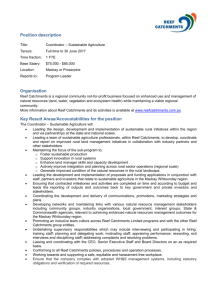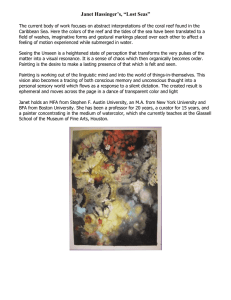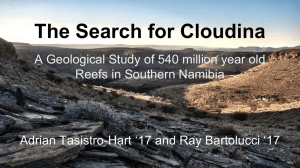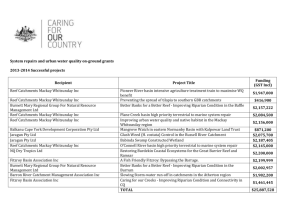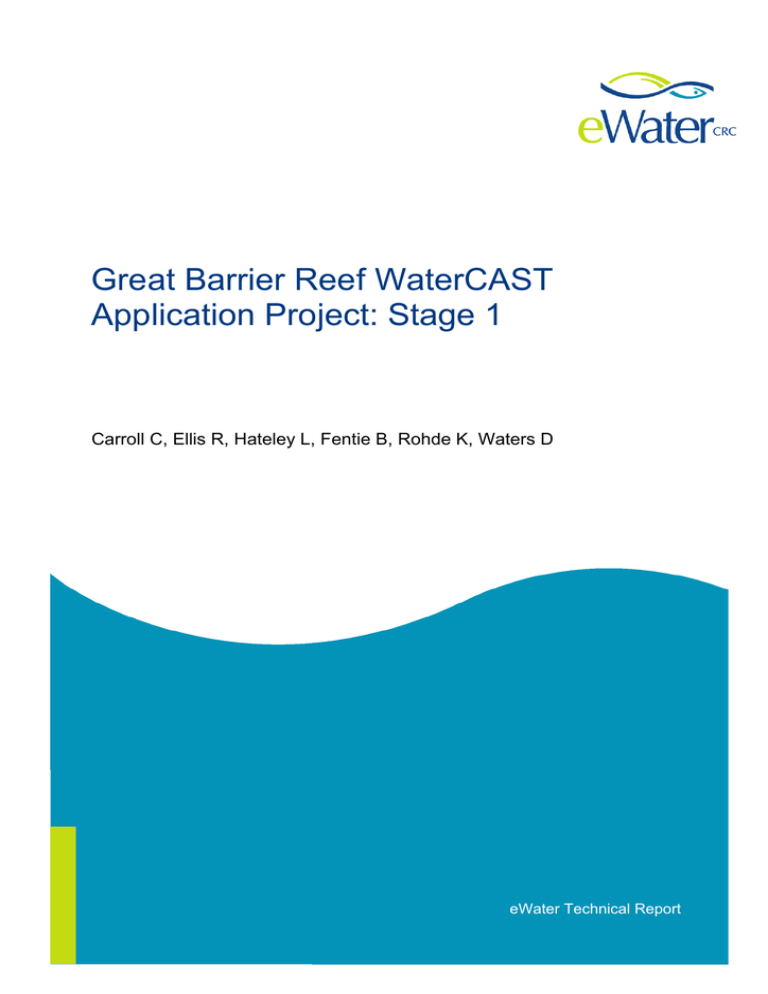
Great Barrier Reef WaterCAST
Application Project: Stage 1
Carroll C, Ellis R, Hateley L, Fentie B, Rohde K, Waters D
eWater Technical Report
Great Barrier Reef
WaterCAST Application Project: Stage 1
Carroll C, Ellis R, Hateley L, Fentie B, Rohde K, Waters D
Queensland Department of Environment & Natural Resources
November 2010
eWater Cooperative Research Centre Technical Report
Contact for more information:
Dr Chris Carroll
Queensland Department of Environment & Natural Resources
PO Box 1762
ROCKHAMPTON Q4700
chris.carroll@derm.qld.gov.au
© eWater Cooperative Research Centre 2010
All rights reserved. No parts of this work may be reproduced in any form or by any means - graphic, electronic, or
mechanical, including photocopying, recording, taping, or information storage and retrieval systems - without the
written permission of the publisher.
Products that are referred to in this document may be either trademarks and/or registered trademarks of the
respective owners. The publisher and the author make no claim to these trademarks.
While every precaution has been taken in the preparation of this document, the publisher and the author assume
no responsibility for errors or omissions, or for damages resulting from the use of information contained in this
document or from the use of programs and source code that may accompany it. In no event shall the publisher
and the author be liable for any loss of profit or any other commercial damage caused or alleged to have been
caused directly or indirectly by this document.
Published online November 2010
ISBN 978-1-921543-39-5
eWater CRC
Innovation Centre, University of Canberra
ACT 2601, Australia
Phone (02) 6201 5168
Fax
(02) 6201 5038
Email info@ewatercrc.com.au
Web www.ewatercrc.com.au
eWater CRC is a cooperative joint venture whose work supports the ecologically and economically sustainable
use of Australia’s water and river systems. eWater CRC was established in 2005 as a successor to the CRCs for
Freshwater Ecology and Catchment Hydrology, under the Australian Government’s Cooperative Research
Centres Program.
Table of Contents
Executive Summary.................................................................................................................................... ii
1
Introduction ........................................................................................................................................ 1
2
Outcomes............................................................................................................................................ 1
2.1 Hydrology and water quality modeling to inform WQ monitoring. ...................................................... 1
2.2 Quantify the uncertainty in modelled runoff and pollutant loads and parameter uncertainty in the
Fitzroy (Ellis et al. 2009)............................................................................................................................ 2
2.2.1
Calibration approach ............................................................................................................... 3
2.2.2
Flow predictions ...................................................................................................................... 3
2.2.3
Outcomes................................................................................................................................ 6
2.3 Communication of current and emerging modelling tools to support delivery of the Reef Water
Quality Protection Plan............................................................................................................................... 6
3
Conclusions........................................................................................................................................ 7
References .................................................................................................................................................. 8
Appendix 1………………………………………………………………………………………….........................8
Appendix 2…………………………………………………………………………………………………………..12
Executive Summary
The Great Barrier Reef World Heritage Area is an area of both national and
international significance, with outstanding natural, social and economic values. Over
the past 150 years reef catchments have been extensively modified leading to a
decline in water quality entering the GBR lagoon. A joint Queensland and Australian
government initiative has responded to these water quality concerns and threats with
the production of the Reef Water Quality Protection Plan.
An aim of the eWater CRC Application Projects is better develop and apply products to
real world scenarios and problems. The GBR eWater Application Project provided an
opportunity to:
Undertake hydrology and Water Quality Modelling in selected reef catchments to
inform WQ monitoring.
Quantify the uncertainty in modelled runoff and pollutant loads and parameter
uncertainty, focussing on the Fitzroy basin, and
Communicate current and emerging modelling tools to support delivery of the
Reef Water Quality Protection Plan.
The Barron, Burdekin, Fitzroy, and Pioneer were the four reef catchments where
WaterCAST was applied.
Although key land uses generating constituent loads were identified in each of the four
catchments it was acknowledged there is still uncertainty on the spatial and temporal
contribution of erosion processes, both sources and sinks; particularly in the larger reef
catchments such as the Burdekin and Fitzroy.
In addition sediment and nutrient transmission losses and nutrient decay within stream
are required to support future model predictions. Importantly, in all catchments
monitoring the presence of herbicides continue to emerge as constituents of concern
that are not currently being modelled by WaterCAST.
Calibration of model parameters was undertaken within the WaterCAST framework,
rather than in a secondary environment like the Rainfall Runoff Library. The calibration
was able to consider all internal interactions and resulted in an improved statistical fit.
Calibrating parameters in such a way currently requires the use of optimisation
software, such as PEST. Using PEST has also allowed a quantifiable assessment of
parameter and prediction uncertainty.
ii
1 Introduction
The Great Barrier Reef World Heritage Area is an area of both national and
international significance, with outstanding natural, social and economic values. Over
the past 150 years reef catchments have been extensively modified leading to a
decline in water quality entering the GBR. The health of the Great Barrier Reef is a
concern with the degradation of coral reefs attributed to elevated levels of sediment,
nutrients and pesticides entering the reef lagoon from adjacent coastal catchments
(Brodie et al. 2008).
In 2003 a joint Queensland and Australian government initiative has responded to
these water quality concerns and threats with the production of the Reef Water Quality
Protection Plan (RWQPP). The RWQPP has since been updated in 2009, however the
main goals remain to halt and reverse the decline in water quality entering the reef,
with the specific objectives to:
Reduce the load of pollutants from diffuse sources in the water entering the Reef.
Rehabilitate and conserve areas of the Reef catchment that have a role in
removing water borne pollutants.
A reef catchment water quality monitoring program (Action I5) commenced in 2004. In
a review Grayson (2007) stated that an integrated use of monitoring and modelling ‘is
the only way to establish loads and trends and begin to assess the impacts of
management actions at the scales required for the GBR’. Grayson also recognised that
while the use of modelling to inform expectations in trends and load estimation is a
powerful approach, ‘the associated uncertainty must be conveyed to all users’.
Previous modelling for high priority GBR catchments had been undertaken using the
SedNet and ANNEX models (Cogle, Carroll, Sherman 2006). In Stage 1 (2007-2009)
the GBR Application Project aimed to apply and test the E2 framework in 4 GBR
catchments: Barron, Burdekin, Fitzroy, and Pioneer
Three main activities were:
Hydrology and Water Quality Modelling to inform WQ monitoring.
Quantify the uncertainty in modelled runoff and pollutant loads and parameter
uncertainty in the Fitzroy
Communication of current and emerging modelling tools to support delivery of the
Reef Water Quality Protection Plan.
Stage 2 commenced in January 2010 and is a significant expansion on the work
started in Stage 1. Stage 2 will include the modelling of all catchments in the GBR
using Source Catchments as a requirement of state and federal government reef
reporting. Detailed reporting of Stage 2 will be provided in 2011.
2 Outcomes
2.1
Hydrology and water quality modeling to inform WQ monitoring.
Following WaterCAST modelling (Appendix 1) and along with other modelling sources,
a series of questions were addressed to inform the water quality monitoring in the four
GBR catchments (Appendix 2). The questions were:
1. What land use, management systems are generating the highest end of system
runoff and constituent loads (identify key constituents & catchments)?
eWater CRC
Great Barrier Reef WaterCAST Application Project: Stage 1
1
2. What are the dominant erosion processes occurring in the catchments, subcatchments?
3. Based on the modeling, and monitoring, what locations would you recommend
further loads WQ monitoring is undertaken?
4. What would be the highest priority catchments for I5 to monitor? Why?
Although key land uses generating constituent loads were identified in each of the four
catchments there is still uncertainty on the spatial and temporal contribution of erosion
processes, both sources and sinks; particularly in the larger reef catchments such as
the Burdekin and Fitzroy. In the Barron cropping is estimated to have a TSS arial
delivery ratio (ADR) of 2 (% of load delivered by land use to the GBR, divided by the %
of catchment occupied by the land use). Thus, cropping contributes twice as much TSS
as you would expect from the area of land; whereas, sugar cane has an ADR of 1.6.
Coastal sub-catchments of Barron and Trinity have high TSS, TN and TP but there is
no monitoring below the final gauging station monitoring point. The Barron catchment is
seen as a priority monitoring site to support water quality modelling, along with
Mareeba and Myola gauging stations.
In the Fitzroy basin the Connors/Isaac and the Mackenzie sub-catchments were seen
as high priority areas for water quality monitoring, and further gully erosion monitoring.
A measure of soil erodibility in the Clarke Connors range would be valuable in
validating the modelled sediment loads that have been previously derived via SedNet.
In the Pioneer sugar cane is the major land use that contributes DIN and DIP nutrients
to the reef. In the Mackay region the Pioneer and Sandy creek catchments have the
largest area of sugar cane along with flow gauging stations, hence should be a priority
monitoring site to build on existing water quality data.
In addition sediment tracing analysis would be useful to identify and help verify relative
contributions of erosion processes; hill, gully, streambank, particularly in the basins
with extensive grazing. In addition sediment and nutrient transmission losses and
nutrient decay within stream are required to support future model predictions.
Importantly, in all catchments monitoring the presence of herbicides continue to
emerge as constituents of concern that are not currently being modelled by
WaterCAST.
2.2
Quantify the uncertainty in modelled runoff and pollutant loads and
parameter uncertainty in the Fitzroy (Ellis et al. 2009)
To investigate hydrologic parameter estimation and uncertainty the Fitzroy River
Catchment was represented in a WaterCAST scenario by 396 subcatchments (figure
1). These sub-catchments were the result of an automated WaterCAST DEM process,
with additional sub-catchments placed to allow representation of major water storages
within the stream network. Each sub-catchment had 7 ‘Functional Units’ nominally
assigned based on land use. Each functional unit instance was assigned a SIMHYD
rainfall-runoff model, each link in the node-link network was assigned a Laurenson nonlinear flow routing model, except for 12 links where a water storage model was applied.
A calibration period from 1st January 1985 to 31st December 2005 was selected.
Climate inputs for rainfall-runoff models were sourced from the SILO Data Drill.
For constituent generation (total suspended solids – TSS) parameter estimation and
uncertainty analysis, a smaller region within the Fitzroy Catchment was studied. This
40, 000 km2 ‘Beckers’ area comprises most of the Dawson River Valley (figure 1), and
is represented in the WaterCAST project by 119 subcatchments. A calibration period
from 1st January 1986 to 31st December 2005 was selected.
eWater CRC
Great Barrier Reef WaterCAST Application Project: Stage 1
2
Figure 1. Fitzroy River Catchment with flow observation points (gauging stations) and
subcatchments indicated. Subcatchments are shaded by calibration ‘region’, with the ‘Beckers’
study area also indicated.
2.2.1 Calibration approach
The study area was broken into 20 calibration ‘regions’ according to the subcatchments
contributing to the 20 gauging stations with daily flow observations (figure 1).
Throughout these regions the WaterCAST entities of subcatchments, functional units,
links and nodes continued to operate as discrete units, however models belonging to
similar ‘types’ were grouped for calibration using PEST (Parameter ESTimation), a
model independent suite of parameter estimation and uncertainty analysis tools. This
method of parsimony implies uniformity within, but not between, calibration regions.
Each SIMHYD model presented to PEST had 7 parameters available for adjustment.
Each Laurenson non-linear flow routing model had 2 parameters available for
adjustment. Parameter ranges were limited to those recommended in the relevant user
guides.
PEST utility was used to compare modelled flow outputs with observed data in a 60part multi-component objective function. This objective function was comprised of the
weighted, sum of squared residuals for daily flows, daily ‘baseflows’, and monthly
volume accumulations at each calibration gauging station. The combination of various
flow ‘functions’ in an objective function was shown to give satisfying ‘fits’ in small scale
trials.
2.2.2 Flow predictions
Statistically the ‘calibrated’ hydrology parameter set yields flow predictions that provide
a good match between observed and modelled flows at 20 locations throughout the
catchment. The PEST derived calibration parameter set was able to consider all model
interactions and individual climate inputs throughout the 20 regions simultaneously,
which is an advantage over most other calibration methods.
eWater CRC
Great Barrier Reef WaterCAST Application Project: Stage 1
3
Also of importance to modellers is the visual ‘fit’ when predicted flows are shown with
observed. Figure 2 illustrates a visual comparison for the PEST derived calibration.
6000
Calibrated Prediction
Observed Flow
Daily Flow (Cubic Metres Per Second)
5000
4000
3000
2000
1000
1/
01
/1
1/ 9 98
03
/1
1/ 9 98
05
/1
99
1/
07 8
/1
1/ 9 98
09
/1
1/ 9 98
11
/1
1/ 9 98
01
/1
1/ 9 99
03
/1
99
1/
05 9
/1
1/ 9 99
07
/1
1/ 9 99
09
/1
1/ 9 99
11
/1
1/ 9 99
01
/2
1/ 0 00
03
/2
1/ 0 00
05
/2
1/ 0 00
07
/2
1/ 0 00
09
/2
1/ 0 00
11
/2
1/ 0 00
01
/2
1/ 0 01
03
/2
1/ 0 01
05
/2
1/ 0 01
07
/2
00
1/
09 1
/2
1/ 0 01
11
/2
00
1
0
Figure 2. Comparison of predicted daily flow with observed daily flow at gauging station 130003AB
for 1998 – 2001.
PEST utilities were then used to produce 50 alternative parameter sets that satisfied
the statistical requirements of the calibration objective function. These 50 ‘realisations’
of calibrated parameter sets can be used to provide a quantitative assessment of
uncertainty around parameter values and the resulting model predictions. Figure 3
shows this analysis graphically for the ranges of 2 SIMHYD parameters, figure 4 shows
the range of model predictions of stream flow for a selected event.
eWater CRC
Great Barrier Reef WaterCAST Application Project: Stage 1
4
Gauge 130105A Grazing Open Soil Moisture Storage Capacity
50
Parameter Range
Contains Calibrated Value
40
Count
30
20
10
0
95
140
185
230
275
320
365
410
455
500
Gauge 130322A Grazing Open Infiltration Shape
50
Parameter Range
Contains Calibrated Value
40
Count
30
20
10
0
1
2
3
4
5
6
7
8
9
10
Figure 3. Frequency histograms representing the range of values for individual parameters within
50 calibrated realisations of parameter sets, categories that include the parameter value from the
initial regularised calibration have a darker shading. Parameters represented range from a ‘high’
objective function sensitivity (A) to low objective function sensitivity (B).
3000
Daily Flow (cubic metres per second)
Random Calibrated Realisations
Calibrated Prediction
2500
Observed Flow
2000
1500
1000
500
1/
03
/9
0
8/
03
/9
0
15
/0
3/
90
22
/0
3/
90
29
/0
3/
90
5/
04
/9
0
12
/0
4/
90
19
/0
4/
90
26
/0
4/
90
3/
05
/9
0
10
/0
5/
90
17
/0
5/
90
24
/0
5/
90
31
/0
5/
90
7/
06
/9
0
14
/0
6/
90
21
/0
6/
90
28
/0
6/
90
5/
07
/9
0
12
/0
7/
90
19
/0
7/
90
26
/0
7/
90
0
Figure 4. Model predicted daily flow (and observed daily flow) for gauge 130003AB for the period
March – July 1990, including predictions from 50 calibrated parameter set
eWater CRC
Great Barrier Reef WaterCAST Application Project: Stage 1
5
For generation of TSS using the EMC/DWC model in the Dawson Valley project area,
PEST was used to produce 133 ‘realisations’ of EMC/DWC parameter values that
satisfied the objective function achieved during calibration, each realisation retaining
the user defined ratios of parameter values between Functional Units. Figure 5 shows
the results of this analysis for a selected period.
1000
Random Calibrated Realisations
900
Calibrated Prediction
TSS Concentration (mg/L)
800
TSS Observations
700
600
500
400
300
200
100
8/
02
/9
6
1/
02
/9
6
25
/0
1/
96
18
/0
1/
96
11
/0
1/
96
4/
01
/9
6
28
/1
2/
95
21
/1
2/
95
14
/1
2/
95
7/
12
/9
5
30
/1
1/
95
23
/1
1/
95
16
/1
1/
95
0
Figure 5. Daily model predictions of TSS concentration at gauge 130324A between November 1995
and March 1996. Model predictions are made from the calibrated parameter set and 133 random
parameter sets that also satisfy the calibration objective function.
2.2.3 Outcomes
By calibrating model parameters within the WaterCAST environment, rather than in a
secondary environment like the Rainfall Runoff Library, the calibration was able to
consider all internal interactions. This has resulted in a statistical fit that is a clear
improvement. Calibrating parameters in such a way currently requires the use of
optimsation software, such as PEST. Using PEST has also allowed a quantifiable
assessment of parameter and prediction uncertainty.
2.3
Communication of current and emerging modelling tools to support
delivery of the Reef Water Quality Protection Plan.
In February 2009 regional visits were undertaken to Reef Natural Resource
Management groups to provide an overview on the WaterCAST modelling framework
and associated uncertainty analysis approach using PEST.
In addition a workshop on ‘Calibration and Predictive Uncertainty Analysis of
WaterCAST Models using PEST’ was conducted for Queensland eWater CRC
stakeholders in March 2009. Participants were invited to bring their own WaterCAST
projects for analysis and discussion, along with any observation data they had to use
for calibration, or any other data that may help to communicate the composition and
structure of their scenario. The workshop covered: traditional parameter estimation,
demonstration & implementation of PEST, WaterCAST as a command line program,
regionalisation of model parameters, classical approach to parameter estimation,
eWater CRC
Great Barrier Reef WaterCAST Application Project: Stage 1
6
calibration of surface water models, traditional uncertainty analysis, highly
parameterised analysis along with hands WaterCAS/PEST command line exercises.
3 Conclusions
The GBR Application Project successfully applied the WaterCAST modeling framework
in four reef catchments; Barron, Burdekin, Pioneer and Fitzroy. The WaterCAST
modeling along with previous SedNet/Annex modeling was able to inform the
catchment monitoring program on prioritizing critical water quality monitoring sites. An
approach to quantify modeling uncertainty using the Parameter ESTimation tool with
WaterCAST was demonstrated to both Regional Natural Resource Management
groups and Queensland eWater CRC stakeholders, with training supplied to key
stakeholder users.
Although challenges remain to timely and efficiently run WaterCAST and PEST on
large reef catchments it has now been adopted to report on water quality targets
outlined in the 2009 Water Quality Improvement Plan.
eWater CRC
Great Barrier Reef WaterCAST Application Project: Stage 1
7
References
ANNON (2003). The State of Queensland and Commonwealth of Australia. Reef Water
Quality Protection Plan for catchments adjacent to the Great Barrier Reef World
Heritage Area. Queensland Department of Premier and Cabinet, Brisbane.
ANNON (2009). The State of Queensland and Commonwealth of Australia. Reef Water
Quality Protection Plan for catchments adjacent to the Great Barrier Reef World
Heritage Area. Queensland Department of Premier and Cabinet, Brisbane.
www.reefplan.qld.gov.au
Brodie, J., Binny, J., Fabricius, K., Gordon, I., Hoegh-Guldberg, O., Hunter, H.,
O’Reagain, P., Pearson, R., Quirk, M., Thorburn, P., Waterhouse, J., Webster, I., and
Wilkinson, S. (2008). Synthesis of evidence to support the Scientific Consensus
Statement on Water Quality in the Great Barrier Reef. Queensland Department of
Premiers and Cabinet, the Reef Secretariat, August 2009, Brisbane
Cogle, A.L., Carroll, C., and Sherman B.S. (2006). The use of SedNet and ANNEX to
guide GBR catchment sediment and nutrient target setting. QNRM06138. Department
of Natural Resources Mines and Water, Brisbane.
Ellis, R.J., Doherty J, Searle R.D., and Moodie K. (2009) Applying PEST (Parameter
ESTimation) to improve parameter estimation and uncertainty analysis in WaterCAST
model. 18th World IMACCS/MODSIM Congress Cairns, Australia: 3158-3164
http://mssanz.org.au/modsim09:
Grayson, R. (2007). Data analysis and modeling requirements for water quality loads
monitoring: Great Barrier Reef Water Quality Protection Plan (Action I5). Department
of Natural Resources and water, Natural Resource Sciences, water Quality Processes
Unit. ISBN 1-7417-2451-6.
eWater CRC
Great Barrier Reef WaterCAST Application Project: Stage 1
8
APPENDIX 1: Outline of WatCAST Modelling
Barron – Louise Hateley
WaterCAST modelling was conducted on the Barron River catchment (2,138 km2),
Trinity Inlet (340 km2, including Cairns city, part of the Mulgrave River catchment),
and the Northern Beaches of Cairns (92 km2, part of the Mossman River
catchment). The Barron River has the largest discharge and is sourced from small,
forested, freshwater tributaries on the Atherton Tablelands. Small creeks drain the
Northern Beaches and Trinity Inlet sub-catchments.
Twenty three sub-catchments were generated based on 25 m, hydrologically
correct Digital Elevation Model (DEM), location of gauging stations and water
quality monitoring sites.
Eleven Function Units (FU’s) were used, comprising 10 for land use and 1 for point
sources to represent the 8 sewage treatment plants.
The Sacramento rainfall runoff model was chosen to generate the sub-catchment
runoff generation component of the WaterCAST model. It relates runoff to rainfall
with daily data using soil moisture accounting to simulate the water balance.
Sacramento parameters have been obtained by calibrating observed rainfall, PET
and runoff using the eWater CRC’s Rainfall Runoff Library (RRL). Seven of the 31
stream gauges were suitable for calibration using the Sacramento model.
The Event Mean Concentration (EMC),Dry Weather Concentration (DWC) model
was chosen to generate the constituent component. The water quality constituents
or pollutants chosen for this project are Total Suspended Solids (TSS), Total
Nitrogen (TN) and Total Phosphorus (TP). Sediment and nutrient generation is
based on the application of EMC\) and DWC for each constituent and FU. EMC is
typically much higher than the DWC as run-off volumes are greater during events
and therefore the constituent loads transported by surface run-off are higher than
the loads transported by sub-surface flow during ambient conditions.
Over the long term, the hydrology of the catchment is well represented. Predicted
volumes were within 10% of the observed volumes at 7 gauges used for hydrologic
calibration, as well as at 6 regulated gauges (not used for calibration).
Predicted loads were similar (105-139%) to long term average annual loads of
TSS, TN and TP. For intensively monitored events over 3 years, predicted
volumes were usually higher than observed volumes (140% to 260% of observed).
Predicted loads were also higher than observed loads for TSS (130%), TN (220%)
and TP (170%).
High predicted areal loading ratios are Cropping (TSS and TN), Sugarcane (TN)
and Urban (TN and TP). These are recommended priorities for further research
and extension, including more intensive water quality monitoring.
eWater CRC
Great Barrier Reef WaterCAST Application Project: Stage 1
9
Burdekin - Bantie Fentie
As shown in figure below, a WaterCAST project of the catchment with 55 subcatchments (total area of 128,606 km2) using the 2004 land use map of the
catchment has been developed.
The SIMHYD rainfall-runoff model was calibrated in Rainfall Runoff Library (RRL)
and historical flow data monitored at a number of gauging stations in the
catchment. However, this is now being revised due to uncertainty about the
optimality of the first calibration.
Event Mean Concentration (EMC) and Dry Weather Concentration (DWC) values
for TSS, TN and TP have been estimated from monitoring data and entered in the
model. However, these are being revised using a novel approach of estimating
land-use-specific EMC and DWC values.
The original EMC and DWC values in the model have been scaled against erosion
hazard indices. This scaling will be re-done once the revised EMC and DWC
values have been estimated and entered into the model.
A storage model of the Burdekin Falls Dam is being developed.
Pioneer – Ken Rohde
Base scenario was developed to estimate average annual sediment and nutrient
loads from 1960 to 2006. Existing water quality monitoring data was used to
populate and calibrate.
The Pioneer catchment is 1500 km2
Sixty one sub-catchments were created, with a 25 km2 stream threshold used.
The SIMHYD rainfall runoff model was chosen to generate the sub-catchment
runoff.
Nine FU’s were used.
Four storages were included, 1 dam and 3 in-stream weirs.
eWater CRC
Great Barrier Reef WaterCAST Application Project: Stage 1
10
The EMC/DWC model was chosen to generate the constituent component of the
E2 model. The water quality constituents or pollutants chosen for this project wer
Total Suspended Solids (TSS), Total Nitrogen (TN) and Total Phosphorus (TP).
Sediment and nutrient generation is based on the application of Event Mean
Concentrations (EMC) and Dry Weather Concentrations (DWC) for each
constituent and FU. (this will be completed in next iteration of Source Catchments)
SILO gridded daily rainfall data was used with PET derived from NLWRA national
monthly maps
Fitzroy – Rob Ellis
WaterCAST was conducted on Fitzroy River catchment (142,000 km2).
396 subcatchments were generated.
Each subcatchment has 7 Fuctional Units (FU’s) based on land use.
Each FU instance was assigned a SIMHYD rainfall-runoff model, each link in the
node-link network was assigned a Laurenson non-linear routing model, with 12
links representing water storages.
An Event Mean Concentration/Dry Weather Concentration EMC/DWC model was
applied to each FU to generate sediment from each subcatchment. The EMC/DWC
values used were sourced from a calibration project in Dawson Valley sub-region of
the Fitzroy catchment.
The study area was broken into 20 calibration ‘regions’ according to the
subcatchments contributing to the 20 gauging stations with daily flow observations
(figure 1). Throughout these regions the WaterCAST entities of subcatchments,
functional units, links and nodes continued to operate as discrete units, however
models belonging to similar ‘types’ were grouped for PEST assessment.
Observed daily flow totals were extracted from NR&W’s corporate data base
environment ‘Hydstra Surface Water Database’. A baseflow separation algorithm
was applied to the observed daily flow, with the resulting baseflow ‘observations’
also used in calibration.
A PEST utility program, Time Series Processor (TSPROC), was used as a postmodel processor to compare modelled flow outputs with observed data in a 60-part
multi-component objective function.
This objective function was comprised of the weighted, sum of squared residuals
for daily flows, daily baseflows’, and monthly volume accumulations at each
calibration gauging station. The combination of various flow ‘functions’ in an
objective function was shown to give satisfying ‘fits’ in small scale trials, and may
also help to avoid the optimisation problem of ‘local minima’.
Statistically the ‘calibrated’ parameter set yields flow predictions that provide a good
match between observed and modelled flows at 20 locations throughout the
catchment. The parameter sets from the RRL made use of a variety of optimisation
techniques, and considered daily flow and total volume components, however the
RRL environment can not account for the effects of flow routing and water storages.
The PEST derived calibration parameter set was able to consider all of these
interactions throughout the 20 regions simultaneously.
By calibrating model parameters within the WaterCAST environment, rather than in
a secondary environment like the Rainfall Runoff Library, the calibration was able to
consider all internal interactions.
Applying PEST (Parameter ESTimation) to improve parameter estimation and
uncertainty analysis in WaterCAST models, this has resulted in a statistical fit that
is a clear improvement.
This uncertainty analysis technique introduces a degree of subjectivity into the
process. The modeller must supply estimates of likely parameter distributions prior
to the production of random parameter sets. Despite these subjectivities and
eWater CRC
Great Barrier Reef WaterCAST Application Project: Stage 1
11
simplifications, the resulting uncertainty analysis is transparent, quantifiable, readily
communicable and applicable at the scale at which this type of water quality model
informs land management decisions.
eWater CRC
Great Barrier Reef WaterCAST Application Project: Stage 1
12
Appendix 2
Questions addressed to inform water quality monitoring in Barron, Burdekin, Pioneer and Burdekin catchments.
Questions
Barron
Burdekin
TSS (total):
Native Pastures, Forest and other
reserves, Cropping, Improved
Pastures, Sugarcane
TSS per unit area:
Cropping, Native Pastures,
Improved Pastures, Sugarcane,
Forest and other reserves
Source: (Roth et al., 2003)
Hillslope (38%)
Gully (39%)
Streambank (23%)
Sugar cane – dissolved
nutrients and herbicides
Dryland cropping – EMC
Grazing – TSS loads
Connors catchment in Isaacs
sub-basin lowest TSS EMC
and highest flows.
2.What are dominant erosion
processes occurring in the
catchments, sub-catchments?
Cropping high ADRa of 2 for TSS,
Sugar high ADR of 1.6 for TN,
Urban high ADR of 2 for TN.
Coastal sub-catchments of Barron
and Trinity have high TSS, TN and TP
but no gauging as below EOS
monitoring.
Pesticides continue to emerge as a
concern – and need to be included?
Mareeba subcatchment to validate
model output highlighting cropping in
this sub-catchment.
Hillslope
Hillslope (67%)
Gully (26%)
Stream bank (7%)
3. Based on your modelling, and
monitoring, what locations would
you recommend further loads WQ
monitoring is undertaken?
Continuation of Mareeba and Myola,
consideration of Cairns coastal plain
gauging/monitoring to evaluate model
outputs and urban contribution
EMC/DWC based WQ modelling,
monitoring at the outlet of
dominant land use subcatchments based on the
contributions. A nested catchment
approach to monitoring could
benefit from information given in
response to questions 1 and 2
above.
Pioneer @ Dumbleton (existing
site)
Sandy Creek @ Homebush
(new site)
O’Connell @ Caravan Park
(existing site)
Continuation of Gordonstone
Creek , and Spottswood Creek
cascading monitoring sites to
inform sediment and nutrient
delivery ratios.
4. What would be the highest
priority catchments for I5 to
monitor? Why?
Barron is important to support WQIP.
See response to Question 3
above.
Pioneer/Sandy - largest cane
catchments, current flow
gauging stations have
relatively good existing WQ
datasets.
O’Connell – no gauging station
and difficult to sample. Lower
priority.
Major basin and individual subbasins.
1.What land use, management
systems are generating the
highest end of system runoff and
constituent loads (identify key
constituents & catchments)?
eWater CRC
Pioneer
Fitzroy
Great Barrier Reef WaterCAST Application Project
1

